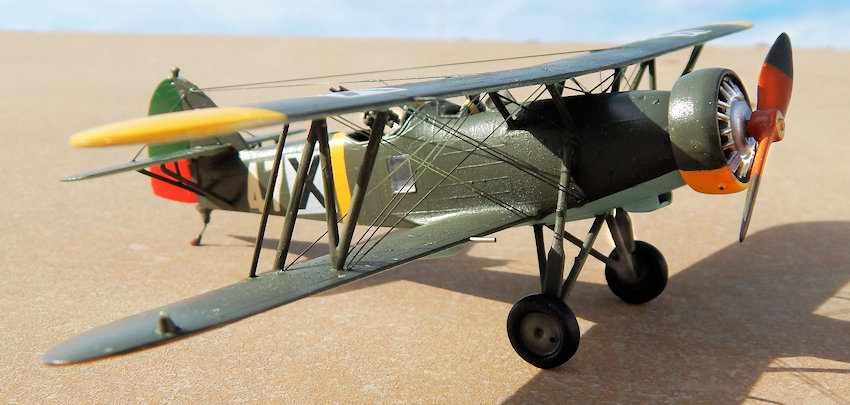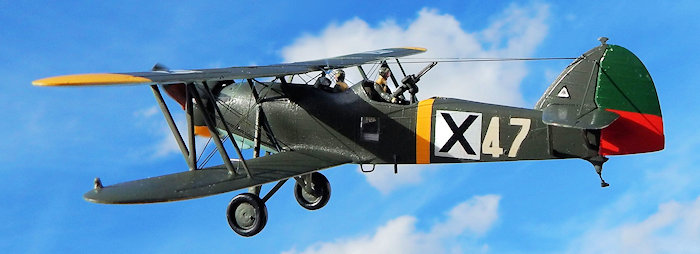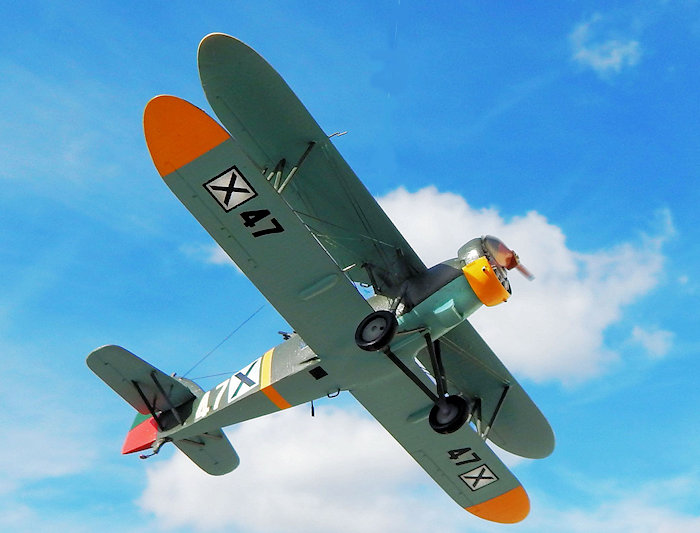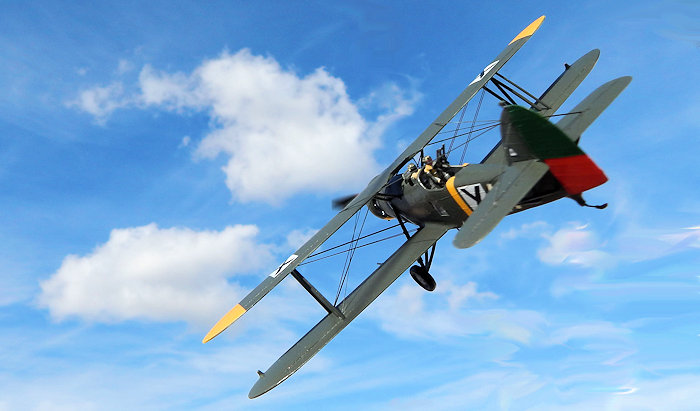
KP 1/72 Letov S.328
| KIT #: | 5 |
| PRICE: | $ |
| DECALS: | Two options |
| REVIEWER: | Carmel J. Attard |
| NOTES: |

| HISTORY |
The Letov S328 of Czechoslovakia origin was a two seat, single engine biplane regarded as a general-purpose type of aircraft that continued to be involved during the extensive operations well into the Second World War. It had an all-metal structure with wings and fuselage fabric covered and the type has outlived many more modern successors.
Bulgarian Air Force purchased 62 Letov Š-328s from Germany in 1939, naming them the Vrana (Crow), of which 30 were produced after German occupation of Czechoslovakia. Till 1942 they were also used for anti-submarine patrols over the Black Sea. They remained in service until at least September 1944.
 3rd Reconnaissance (Rasusnavane) Orlyak (313rd Yato
was equipped with Letov S-328 x 12 in Yambol, 323rd Yato with Letov S-328 x 12
in Yambol, 333rd Yato with Letov S-328 x 12 in Yambol, 343rd Yato with Letov
S-328 x 12 in Yambol, 373rd Yato (training) with DAR-3 x 3 and KB-4 x 6 in
Yambol).
3rd Reconnaissance (Rasusnavane) Orlyak (313rd Yato
was equipped with Letov S-328 x 12 in Yambol, 323rd Yato with Letov S-328 x 12
in Yambol, 333rd Yato with Letov S-328 x 12 in Yambol, 343rd Yato with Letov
S-328 x 12 in Yambol, 373rd Yato (training) with DAR-3 x 3 and KB-4 x 6 in
Yambol).
On 26th June, 343 Army Yato deployed 9 Letov S-328 Vranas at Kavalla Airfield as part of its task to provide air support to the Aegean Otryad (Detachment). This involved aerial reconnaissance of the coast between Solun (Thessalonica) and Dedeagach (Alexandroupolis) striking enemy maritime communications and preventing sea borne landings, mapping Aegean Thrace for the first Army Staff, and providing liaison services between Bulgarian and German forces in the territory.
The newly created Mixed Yato with its two Krilos (Flights) one at Balchik Airfield (2 Army Polk, Five Letov S 328 Vranas) and one at Sarafovo Airfield near Burgas (3 Army Polk, four Letov S 328Vranas) had the same task, but over the Black Sea coast.
 The unit found the tasks hard to conduct, mainly due
to their obsolete Czechoslovakian mounts. From late June 1941 until early the
following year, Bulgarian crews flew intensive reconnaissance over the Aegean as
far as south of Crete. By early 1942 they had flown over 300 missions, most of
them before 1st November. After
that day, Kavalla hosted only five Do-17M Uragans, the rest of the force
returning to Plovdid for the winter.
The unit found the tasks hard to conduct, mainly due
to their obsolete Czechoslovakian mounts. From late June 1941 until early the
following year, Bulgarian crews flew intensive reconnaissance over the Aegean as
far as south of Crete. By early 1942 they had flown over 300 missions, most of
them before 1st November. After
that day, Kavalla hosted only five Do-17M Uragans, the rest of the force
returning to Plovdid for the winter.
The Black Sea was the scene of greater challenges. Despite the rapid German advance into the USSR, these waters remained under the control of the Soviet Navy. Air units were reinforced by 3 Army Air Polk 333 Army Yato, which relocated six Letov S328 Vranas from Yambol to Sarafovo. The newly created Orliak had its Staff at Chayka Seaplane Station.
Despite the fact that units fielded half of their available strength the period from the 6th August and closing months of 1941 they managed to fly 173 recce, patrol and convoy missions. Bulgarian crews used their arms in anger on numerous occasions. This usually consisted of 20 Kilo bombs employed against torpedo attacks. No evidence exists of sunken enemy shipping.
| THE KIT |
 The Letov S328 had been produced by the Czech company
KP in 1/72 scale and the kit was typical of the era of 20 years ago. It can be
built as a twin float arrangement known as S 328V or as a land plane type. The
kit is a typical Czech model production and one should go about pointing out the
weak points that need correcting or replacing. The kit has fine raised detail
much of which will be lost during construction, sanding etc. There are no
locating pins and correct alignment of parts is imperative before parts are
allowed to set. The kit contained a good amount of flash on all parts and
patience and time was required in cleaning of parts before construction starts.
The Letov S328 had been produced by the Czech company
KP in 1/72 scale and the kit was typical of the era of 20 years ago. It can be
built as a twin float arrangement known as S 328V or as a land plane type. The
kit is a typical Czech model production and one should go about pointing out the
weak points that need correcting or replacing. The kit has fine raised detail
much of which will be lost during construction, sanding etc. There are no
locating pins and correct alignment of parts is imperative before parts are
allowed to set. The kit contained a good amount of flash on all parts and
patience and time was required in cleaning of parts before construction starts.
| CONSTRUCTION |
Close study indicates that the fabric areas are not well represented and little could be done to improve on this aspect. The two square observation fuselage windows are a little small and needs to enlarge by 1/16” to the length and width and replace the clear parts for these accordingly with new ones cut from clear styrene. There is also a smaller square window at the base mid fuselage section, which was cut; apparently this was a place where an aerial camera was accommodated.
 The cockpit interior lacked certain details. None of
the interior pipe work structure is apparent apart from some detail to the side
of fuselage walls, but with the small area from where this can be visible it was
not worth going into detail apart from detailing the pilot seat, like adding
seat straps; instruments painted and the area around the gunner. The interiors
were painted silver and the fuselage was closed and left aside to dry. The long
parallel wings were then cleaned from flash and drilled at marked localities for
rigging using fine pin drill.
The cockpit interior lacked certain details. None of
the interior pipe work structure is apparent apart from some detail to the side
of fuselage walls, but with the small area from where this can be visible it was
not worth going into detail apart from detailing the pilot seat, like adding
seat straps; instruments painted and the area around the gunner. The interiors
were painted silver and the fuselage was closed and left aside to dry. The long
parallel wings were then cleaned from flash and drilled at marked localities for
rigging using fine pin drill.
The lower wing was then added to the fuselage. The tail sections were also added at this stage adding the tail plane struts and the upper string that secures it. This was missing from the kit. Two fairings were added at mid wing underside to correspond with two machine guns fitted on the leading edge of the lower wings. Joining lines on fuselage were also sanded smooth at this stage. The engine Townsend ring had two short exhaust pipes added to its lower sides that corresponded with the pipe work within the ring at front of the radial engine. The two wheels were reshaped as best one could to eliminate the massive step all round caused by mould slip. The assembly was then continued according to the instructions. The upper wing was fixed on top of the struts and rigging applied using invisible mending thread.
| COLORS & MARKINGS |
 I went for a Bulgarian color scheme, which is
featured in the Delta Decal sheet DD72-002, but altering the registration number
to 47 instead of 7 and adding the lower half of the ring in yellow. The model
was given a coat of Dunkelgrun 71 to upper surfaces and Light blue to lower
surfaces with yellow identification markings where appropriate to mid fuselage
and wing tips. Masking in between wings was a bit of a headache and time
consuming but no specific problems were encountered. The model was then given a
coat of Klear before applying the decals mainly consisting of the national
insignia and white numbers to the fuselage sides. This was repeated in black to
the under-wings. The twin machine gun and tailskid were added in the end. The
twin bladed, wooden, paddle-bladed propeller was painted half wood and the
outside in olive green while the boss flange was picked out in brass. Finally
the model was given an overall coat of satin lacquer.
I went for a Bulgarian color scheme, which is
featured in the Delta Decal sheet DD72-002, but altering the registration number
to 47 instead of 7 and adding the lower half of the ring in yellow. The model
was given a coat of Dunkelgrun 71 to upper surfaces and Light blue to lower
surfaces with yellow identification markings where appropriate to mid fuselage
and wing tips. Masking in between wings was a bit of a headache and time
consuming but no specific problems were encountered. The model was then given a
coat of Klear before applying the decals mainly consisting of the national
insignia and white numbers to the fuselage sides. This was repeated in black to
the under-wings. The twin machine gun and tailskid were added in the end. The
twin bladed, wooden, paddle-bladed propeller was painted half wood and the
outside in olive green while the boss flange was picked out in brass. Finally
the model was given an overall coat of satin lacquer.
| CONCLUSIONS |
In spite of its age the Letov was pleasing to build and added yet another piece of history to my Bulgarian section of models.
| REFERENCES |
1. Wikipedia encyclopaedia
2. Air Power of the Kingdom of Bulgaria.
March 2016
Copyright ModelingMadness.com
If you would like your product reviewed fairly and fairly quickly, please contact the editor or see other details in the Note to Contributors.